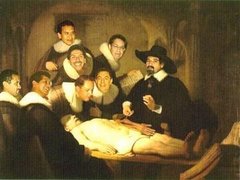EN PEDIATRIA NO TODO ES INFECCION "VIRAL" Y "DESHIDRATACION" ...
An Infection, Unnoticed, Turns Unstoppable
By JIM DWYER
For a moment, an emergency room doctor stepped away from the scrum of people working on Rory Staunton, 12, and spoke to his parents.
“Your son is seriously ill,” the doctor said.
“How seriously?” Rory’s mother, Orlaith Staunton, asked.
The doctor paused.
“Gravely ill,” he said.
How could that be?
Two days earlier, diving for a basketball at his school gym, Rory had cut his arm. He arrived at his pediatrician’s office the next day, Thursday, March 29, vomiting, feverish and with pain in his leg. He was sent to the emergency room at NYU Langone Medical Center. The doctors agreed: He was suffering from an upset stomach and dehydration. He was given fluids, told to take Tylenol, and sent home.
Partially camouflaged by ordinary childhood woes, Rory’s condition was, in fact, already dire. Bacteria had gotten into his blood, probably through the cut on his arm. He was sliding into a septic crisis, an avalanche of immune responses to infection from which he would not escape. On April 1, three nights after he was sent home from the emergency room, he died in the intensive care unit. The cause was severe septic shock brought on by the infection, hospital records say.
Because sepsis, a leading cause of death in hospitals, can at first look like less serious ailments, a campaign to aggressively identify it for early treatment has been undertaken by a consortium of 55 hospitals in the New York region, including NYU Langone.
Yet nowhere along Rory’s journey, from boy with a bellyache on Thursday to gravely ill boy on Friday night, did anyone act on strong indications that he might be fighting for his life. Critical information gathered by his family doctor and during his first visit to NYU Langone was not used, was not at hand or was not viewed as important when decisions were made about his care, records show.
Moments after an emergency room doctor ordered Rory’s discharge believing fluids had made him better, his vital signs, recorded while still at the hospital, suggested that he could be seriously ill. Even more pointed signals emerged three hours later, when the Stauntons were at home: the hospital’s laboratory reported that Rory was producing vast quantities of cells that combat bacterial infection, a warning that sepsis could be on the horizon.
The Stauntons knew nothing of his weak vital signs or abnormal lab results.
“Nobody said anything that night,” Ms. Staunton said. “None of you followed up the next day on that kid, and he’s at home, dying on the couch?”
NYU Langone declined to discuss any aspects of Rory’s care or hospital procedures.
“Our deepest sympathies go out to the family at this difficult time,” said Lisa Greiner, a hospital spokeswoman.
The Stauntons shared Rory’s medical records with a reporter for The New York Times who had met the boy last summer in a social setting. A full airing of the case, along with a commitment to reforms, his parents said, could save lives. They have hired a lawyer, Thomas A. Moore, but have not decided how they will proceed.
Rory Staunton, 5 feet 9 inches tall and 169 pounds, was big for his age and a student of the world. “The most profound 12-year-old I had ever met,” his debate coach, Kevin Burgoyne, said. For his birthday, his parents gave him flying lessons after Rory, who spent hours on a flight simulator, tracked down an aviation school that accepted students at 12. He devoured the memoir of Chesley B. Sullenberger III, the pilot who safely brought down an airliner on the Hudson River.
“I told him, ‘Sully did some fast math landing that plane,’ and for a short while, he was paying attention to math,” said Ciaran Staunton, Rory’s father. “Then he came back with, ‘Yeah, but by the time I’m a pilot they’ll have a faster way of doing it.’ ”
Rory and his sister, Kathleen, 10, grew up in Sunnyside Gardens, Queens, which their parents, Irish immigrants, regarded as a global village of sublime pleasures: shared courtyards, a rich brew of cultures and merry mobs of children rolling from house to house. Ms. Staunton, the former director of an international student exchange, said neighborhood kids formed their own country, Kidadelphia, designed a flag, and adapted the United States motto for their slogan: “In God and Fun We Trust.” Rory was president. When he was 8, he raided his piggy bank to treat his parents to a Chinese dinner for their wedding anniversary. At the private Garden School in Jackson Heights, he was elected to the student council in seventh grade and led a campaign, Spread the Word to End the Word, to curtail the casual, derogatory use of the term “retarded.”
Last summer, his uncle, a friend of mine, brought Rory, Kathleen and their mother to stay in my family’s vacation home for two nights. Rory would go from barreling down a water slide backward to sizing up President Obama’s prospects for re-election. Fascinated by North Korea, he tried to fathom how a country so afflicted by famine could afford a large army. (His parents recently found a note in his computer to the Swedish ambassador to North Korea.)
At home, said Mr. Staunton, a civic activist and bar owner, they would have nightly shouting matches over homework Rory had not done or dirty clothes he had not picked up, in between scoping out corners of global history.
During gym class on Wednesday, March 28, he dived for a ball and opened a cut on his arm. That night, Ms. Staunton said, Rory mentioned it: “How he presented it to me was, ‘I fell in the gym. Mr. D, the athletic director, put the Band-Aids on. And, I got the ball.’ ”
Then he finished his homework and went to bed.
The bacteria Streptococcus pyogenes is part of the human ecosystem, normally dwelling in the throat or on the skin, areas where the body is well defended. Also known as Group A streptococcus, the strain typically causes strep throat or impetigo.
But if it is able to penetrate soft tissue or blood, “it moves very quickly,” said Dr. Michael B. Edmond, the chairman of the division of infectious diseases at Virginia Commonwealth University. “The mortality rate is high. The clinical findings early in the infection can be relatively subtle.”
The challenge for physicians is recognizing an invasive infection, whether from Group A strep or other pathogens, before the cascading damage of sepsis has picked up too much speed. The consortium of New York hospitals has a goal of starting antibiotics within an hour of spotting sepsis in the emergency room, according to officials with the Greater New York Hospital Association’s Stop Sepsis program.
For every hour’s delay in giving antibiotics after very low blood pressure had set in, a study found, the survival rate decreased by 7.6 percent.
Shortly after midnight on March 29, Ms. Staunton heard Rory retching in the bathroom. “There wasn’t a huge amount of vomit, but he kept saying, ‘My leg, my leg, Mom,’ ” she recalled. Back in bed, he moaned. His mother rubbed his thigh. In the morning, he was weak, his leg still hurt, and his temperature was 104 degrees, his highest ever.
The parents began calling Dr. Susan Levitzky, who had been the family pediatrician for about five years. She saw Rory that evening.
“He was leaning on me as we were walking up to the office, because he could hardly stand from the weakness or pain in his leg,” Ms Staunton said. In the waiting room, Rory vomited. When the doctor swabbed his throat, he vomited on her. The swab test, a rapid but not definitive detector of strep, was negative.
“We showed her the cut on his elbow, and I saw her follow up his arm from the cut,” Ms. Staunton said. “She said, ‘The cut’s not an issue.’ She focused on his stomach. We said, ‘Although you see him throwing up, that’s not what he’s really complaining about.’ Rory and I both said to her that it’s the pain in his leg that’s really bothering him.”
The doctor told them that the leg pain might be from falling in the gym. “Rory said, ‘It wasn’t a fall, it was a skid,’ ” Ms. Staunton recalled.
The parents also remarked that Rory’s skin became blotchy when they pressed a finger on it. Those concerns were well-founded, said Dr. Edmond, the infectious disease specialist, who was not involved in Rory’s care: The mottling, which Dr. Levitzky made note of, could mean that vessels in his skin were constricting from low blood pressure; the leg pain could mean an invasive infection. Rory’s temperature was 102 and his pulse was 140; he was taking 36 breaths a minute. These, too, were “worrisome” observations, Dr. Edmond said.
Nevertheless, Ms. Staunton said, she did not recall being told that any of his vital signs were off: “She said, ‘Make your way over to NYU, and get him rehydrated. He’s vomiting now. He’s going to feel better, and tomorrow, he’ll have diarrhea.’ ”
In a brief phone conversation, Dr. Levitzky said she could not discuss the case. “I sent him to a major medical center,” she said.
Rory arrived at NYU Langone, on First Avenue near 34th Street, at 7:14 that evening and was discharged about two hours later. Hospital records do not reflect any communication with Dr. Levitzky or her findings about the mottled skin.
Like Dr. Levitzky, the NYU physicians believed that Rory’s discomfort was caused by a sick stomach and dehydration. His chart states that “labs, IVF, Zofran” were ordered. Zofran is an antinausea drug; two bags of intravenous fluids, or IVF, were administered; three vials of blood were drawn and sent to the hospital laboratory.
“They did the various checks, up, down, back and forth,” Mr. Staunton said.
A screening tool in the Stop Sepsis program, used when a patient first arrives in the emergency room, calls special attention to a person with three symptoms of a possible eight. At the hospital, Rory showed two: he was breathing 20 times per minute and his pulse was 143.
Two hours later, though, he had three: his temperature had risen to 102, his pulse was 131 and his respiration rate was 22. But by the time those vital signs were recorded, at 9:26 p.m., they had no bearing on his treatment. In fact, the doctor had already decided that Rory was going home. Rory’s “ExitCare” instructions, signed by his father, were printed 12 minutes before those readings.
To the pediatrician who examined and discharged Rory, it seemed that the fluids had done the trick. “Pt improved,” the doctor, Camille Scribner, wrote, prescribing “home supportive care.” There is no sign in the records that Dr. Scribner, described by a senior colleague as “hyper-conscientious,” considered alternative explanations.
“They stated that it was a common flu that was going around,” Mr. Staunton said. “It would start off as high temperature and throwing up, and would end up as diarrhea.”
Dr. Scribner could not be reached for comment through the hospital.
As the Stauntons walked Rory onto First Avenue, the air temperature was in the mid-40s. “He was freezing,” Ms. Staunton said. “He took my coat leaving the hospital. It has a little frilly thing around the collar.”
“Not a thing that a boy of 12 would put on,” Mr. Staunton said.
About three hours later, Rory’s lab results were printed. He was producing neutrophils and bands, white blood cells, at rates that were “very abnormal and would suggest a serious bacterial infection,” Dr. Edmond said.
The Stauntons said they heard nothing about it. In bed, Rory “was groaning in his sleep,” Ms. Staunton said. “I felt the heat of the fever.”
At 10 a.m. on Friday, the Stauntons began calling their pediatrician, Dr. Levitzky. “She told us to do a combination of Tylenol and Motrin,” Ms. Staunton said.
Asked last month about the lab findings, Dr. Levitzky, who is associated with NYU Langone, said, “I never knew that testing was done.”
Rory did have the predicted bout of diarrhea on Friday, which momentarily elated his family. Still, he could barely get to the bathroom. The doctor suggested fluids and crackers.
“‘I told her, ‘I’m not sure you’re getting the picture, Dr. Levitzky,’ ” Mr. Staunton said. “‘I can’t even get him to sit up. I don’t know how you expect me to get food into him.’ ”
Later, a slight touch would make him scream. “Around his nose was gone blue,” Mr. Staunton said. “Down his body side was gone blue.”
At that point, Dr. Levitzky told them to return to the emergency room. They supported him as he walked to the car. “All he said was, ‘Can I please have a wheelchair when I get there?’ ” Ms. Staunton recalled.
In the intensive care unit, his parents tried to mask their worry, Mr. Staunton chatting lightly. But Ms. Staunton noticed her son’s eyes following her. “He said, ‘Mom, my toes are really, really cold,’ ” she said.
After extending an arm for blood to be drawn, “he thanked them when they were finished,” Ms. Staunton said.
He had to be put on a ventilator. Just before he was sedated, Ms. Staunton said, “They told him, ‘We need to figure some stuff out. There are some marks on your body, and you need a little bit of help breathing, so we’re just going to intubate you and it’ll be fine.’ ” First, though, they checked his mental status.
“Do you know what date it is?”
“I know it’s March,” Rory answered.
“Who’s the president of the United States?”
He answered: “Barack Obama.”
His mother smiled.
“Ah,” she said, “but Rory, who is going to be the next one?”
“Barack Obama,” he said.
As the next two days passed, doctors tried anything that might halt the shutdown of Rory’s organs. “I can’t say enough about the I.C.U.,” Ms. Staunton said.
Relatives and a priest gathered bedside, talking of Irish football and tomfoolery and politics. Perhaps, one doctor whispered in a fleeting, hopeful aside, Rory might get away with losing his toes and nose. His skin blackened. He passed no urine. His blood would not clot. His heart had to be restarted twice. Three specialists who chronicled Rory’s decline on his intensive care chart each noted that on Thursday night, when he was sent home from the emergency room, he had a fever and significant signs of infection in his blood.
On Sunday night, Dr. Mayer Sagy, who had not seen Rory on his first visit to the hospital but spent the weekend struggling to keep him alive, told the Stauntons that the team had been unable to resuscitate him a third time.
“I said to him, ‘I brought him here to you the other night and you sent him home,’ ” Ms. Staunton said.
“He said, ‘You have every right to be angry.’ ”
More than anything, the Stauntons said, NYU Langone owes an honest accounting of what happened. Racked with loss, they and others remembered Rory as an unflinching champion of schoolyard underdogs.
“Above all,” Ms. Staunton said, “we know that Rory would want no other child to go through what he went through.”
Una infección inadvertida, se vuelve imparable
por Jim Dwyer
Por un momento, un médico de urgencias se apartó del grupo de personas que atendian a Rory Staunton, 12, y habló a sus padres.
"Su hijo está gravemente enfermo", dijo el médico.
"¿Qué tan seriamente?", Preguntó la madre de Rory, Orlaith Staunton,.
El doctor hizo una pausa.
"Gravemente enfermo", dijo.
¿Cómo puede ser eso?
Dos días antes, al lanzarse por una pelota de baloncesto en el gimnasio de su escuela, Rory se había cortado el brazo. Llegó a la oficina de su pediatra al día siguiente, jueves, 29 de marzo con vómitos, fiebre y dolor en la pierna. Fue enviado a la sala de urgencias del Centro Médico Langone de la NYU. Los médicos estuvieron de acuerdo: Él estaba sufriendo de un malestar estomacal y deshidratación. Le dieron fluidos, le dijeron que tomara Tylenol, y lo enviaron a casa.
Parcialmente camuflado por los problemas comúnes de la infancia, la condición de Rory era, de hecho, ya grave. Las bacterias se había metido en su sangre, probablemente a través del corte en el brazo. Estaba cayendo en una crisis séptica, una avalancha de respuestas inmunes a la infección de la que no se escaparia. El 1 de abril (tres noches después de que él fue enviado a casa desde la sala de emergencia), Rory murió en la unidad de cuidados intensivos. La causa fue shock séptico severo provocado por la infección, de acuerdo a los registros hospitalarios.
Debido a que sepsis, una de las principales causas de muerte en los hospitales, puede a primera vistapresentarse simulando enfermedades menos graves, una campaña agresiva para su identificación y para su tratamiento precoz se ha llevado a cabo por un consorcio de 55 hospitales de la región de Nueva York, incluyendo Langone de la NYU.
Sin embargo, en ninguna parte del largo viaje de Rory, desde niño con un dolor de estómago el jueves al niño gravemente enfermo el viernes por la noche, nadie actuo como si tuviese fuertes indicios de que Rory podría estar luchando por su vida. La información crítica recogida por su médico de familia y durante su primera visita a Langone NYU no fue utilizada, no estaba a la mano o no fue considerada como importante cuando se tomaron decisiones sobre su cuidado de este paciente, según los documentos.
Momentos después de que un médico de la sala de emergencia ordenara el alta de Rory, creyendo que fluidos endovenosos habían mejorado su condicion; sus signos vitales, registrados al mismo tiempo en el hospital, daban indicios que podría estar gravemente enfermo. Incluso señales más claras aparecieron tres horas después, cuando los Stauntons ya estaban en casa: el laboratorio del hospital informó de que Rory estaba produciendo grandes cantidades de células que combaten la infección bacteriana, una advertencia de que sepsis puede estar en el horizonte.
Los Stauntons no sabían nada acerca de sus signos vitales débiles o resultados anormales de laboratorio.
"Nadie dijo nada esa noche", dijo Staunton. "Ninguno de ustedes hizo un seguimiento al día siguiente acerca de este niño, y él estába en casa, muriendose en el sofá?"
Langone de la NYU se negó a discutir los aspectos de la atención de Rory, o los procedimientos del hospital.
"Nuestras más profundas condolencias a la familia en este difícil momento", dijo Lisa Greiner, una portavoz del hospital.
Los Stauntons compartierton los registros médicos de Rory con un reportero de The New York Times que había conocido al muchacho el pasado verano en un entorno social. Una emisión completa del caso, junto con un compromiso a hacer reformas, podria salvar vidas. Se ha contratado a un abogado, Thomas A. Moore, pero no han decidido cómo van a proceder.
Rory Staunton, 5 pies y 9 pulgadas de estatura y 169 libras, era grande para su edad y un estudiante del mundo. "El mas profundo de 12 años de edad que había conocido nunca", su entrenador de debate, Kevin Burgoyne, dijo. Para su cumpleaños, sus padres le dieron lecciones de vuelo después de Rory, quien pasó horas en un simulador de vuelo, localizó a una escuela de aviación que aceptaba a estudiantes de 12 anos de edad. Devoró el libro de memorias de Chesley B. Sullenberger III, el piloto que con toda seguridad hizo aterrizar un avión de pasajeros en el río Hudson.
"Le dije, 'Sully hizo calculos matemáticos rápidos para aterrizar ese avión", y por un corto tiempo, él estaba prestando atención a su curso de matemáticas ", dijo Ciaran Staunton, el padre de Rory. "Luego vino y me dijo con 'Sí, para cuando yo sea piloto habra una forma más rápida de hacer matematicas.'"
Rory y su hermana, Kathleen, 10 años, crecieron en los jardines de Sunnyside, Queens, que sus padres, inmigrantes irlandeses, consideraban como una aldea global de placeres sublimes: patios compartidos, una mezcla de culturas y una multitud de alegres niños rodando de casa en casa. La Sra. Staunton, el ex directora de un intercambio internacional de estudiantes, dijo que los niños del barrio formaron su propio país llamado Kidadelphia, diseñó una bandera, y adapto el lema de los Estados Unidos como su propio lema: ". en Dios y en la diversión confiamos " Rory era el presidente. Cuando tenía 8 años, que rompio su alcancía para invitar a sus padres a una cena china por su aniversario de matrimonio . En la escuela privada Garden en Jackson Heights, fue elegido miembro del consejo de estudiantes en séptimo grado y dirigió una campaña, para poner fin a la Palabra, al uso despectivo de la palabra "retardado".
El verano pasado, su tío, un amigo mío, trajo a Rory, Kathleen y su madre para quedarse en casa de vacaciones de mi familia por dos noches. Rory iría de velocidad por un tobogán de agua hacia atrás para dimensionar las perspectivas de reelección del presidente Obama. Fascinado por Corea del Norte, trató de comprender cómo un país tan afligido por el hambre podía permitirse el lujo un gran ejército. (Sus padres encontraron recientemente en su ordenador una carta al embajador de Suecia en Corea del Norte.)
En casa, dijo el señor Staunton, un activista cívico y dueño de un bar, tenían todas las noches competencias de gritos sobre las tareas que Rory no había hecho o la ropa sucia que no había recogido, en medio de discusiones acerca de la historia mundial.
Durante la clase de gimnasia, el miércoles 28 de marzo, se tiró por una pelota y se abrió un corte en el brazo. Esa noche dijo la señora dijo Staunton, la manera como me lo presento fue…" Me caí en el gimnasio. Sr. D, el director deportivo,me puso una curita. Y segui jugando.
Luego de terminar su tarea se fue a la cama.
La bacteria Streptococcus pyogenes es parte del ecosistema humano, por lo general habita en la garganta o en la piel, las zonas donde se defiende bien el cuerpo. También conocido como estreptococo del grupo A, la cepa típicamente causa la faringitis estreptocócica o impétigo.
Pero si es capaz de penetrar en los tejidos blandos y la sangre ", se mueve muy rápidamente," dijo el Dr. Michael B. Edmond, el presidente de la división de enfermedades infecciosas en la Universidad Virginia Commonwealth University. "La tasa de mortalidad es alta. Los primeros resultados clínicos de la infección pueden ser relativamente sutil. "
El reto para los médicos es el reconocimiento de una infección invasiva, ya sea por estreptococo del grupo A u otros agentes patógenos, antes de que los daños en cascada de la sepsis hayan recogido demasiada velocidad. El consorcio de hospitales de Nueva York tiene el objetivo de comenzar los antibióticos dentro de una hora de detectar la sepsis en la sala de emergencias, de acuerdo a los funcionarios con el programa de la Greater New York Hospital Association “Stop Sepsis”.
Un estudio encontró que por cada hora de retraso en la administración de antibióticos una vez que ya se presenta hypotension, la tasa de supervivencia disminuye en un 7.6 %.
Poco después de medianoche el 29 de marzo, la Sra. Staunton escuchó Rory sufrir arcadas (vomitos) en el baño. "No hubo una gran cantidad de vómito, pero él siguió diciendo:" Mi pierna, mi pierna, mamá '", recordó. De vuelta en la cama, se quejó. Su madre se frotó el muslo. Por la mañana, él estaba muy débil, con la pierna que aún le dolía, y su temperatura era de 104 grados.
Los padres llamaron a la Dra. Susan Levitzky, que había sido el pediatra de la familia durante unos cinco años. Vio a Rory esa noche.
"Estaba inclinado sobre mí mientras caminábamos hasta la oficina, porque no podía soportar la debilidad y el dolor en la pierna", dijo la Sra. Staunton. En la sala de espera, Rory vomitó. Cuando el médico limpió su garganta, vomitó sobre ella. La prueba de cultivo de estreptococo, un detector rápido, pero no definitivo, fue negativa.
"Le mostramos el corte en el codo", dijo Staunton. "Ella dijo:" El corte no es un problema. "Ella se centró en su estómago. Nos dijo: 'Aunque se le ve vomitar, eso no es lo que realmente lo está aquejando. "Rory y yo le dijimos que es el dolor en la pierna que realmente le molestaba."
El médico les dijo que el dolor en la pierna estaba relacionado con la caida en el gimnasio.Rory le aclaro:" No fue una caída, fue un patinazo '", recordó la Sra. Staunton.
Los padres también comentaron que la piel de Rory se llenaba de manchas cuando se presionanaba con un dedo sobre ella.
Esas preocupaciones estaban bien fundadas, dijo el Dr. Edmond, el especialista en enfermedades infecciosas, que no estuvo involucrado en el cuidado de Rory: El moteado, que el Dr. Levitzky hizo nota, podría significar que los vasos sanguineos en su piel estaban en constricción por la presión arterial baja; el dolor en la pierna puede significar una infección invasiva. La temperatura de Rory fue de 102 y su pulso era de 140, sus respiraciones 36 por minuto.
Sin embargo, la Sra. Staunton, dijo, no recordaba que le mencionaronque sus signos vitales estaban inestables: "La pediatra nos dijo, 'Llevalo a la Universidad de Nueva York, y haz que lo rehidraten. Ahora esta vomitando, luegose va a sentir mejor, y mañana, va a tener diarrea. "
En una breve conversación telefónica, el Dr. Levitzky dijo que no podía discutir el caso. "Yo lo transferi a un centro médico importante", dijo.
Rory llegó Langone de la NYU, en la Primera Avenida, cerca de la calle 34, a las 7:14 de la noche y fue dado de alta dos horas más tarde. Los registros hospitalarios no reflejan ninguna comunicación con la Dra. Levitzky ni ninguna conclusion sobre la piel moteada.
Al igual que el Dr. Levitzky, los médicos Universidad de Nueva York creyeron que el malestar de Rory fue causado por un estómago enfermo y por deshidratación. Su historia clinica afirma que " laboratorios, fluidos endovenosos, Zofran (un antiemetico)" fue lo unico que se ordenó. Zofran es un medicamento contra las náuseas, dos bolsas de líquidos por vía intravenosa, se le administró, tres tubos de sangre fueron extraídas y enviados al laboratorio del hospital.
"Ellos hicieron los diferentes controles, arriba, abajo, atrás y adelante", dijo Staunton.
Una herramienta de evaluación en el programa “Stop Sepsis”, que se utiliza cuando un paciente llega por primera vez en la sala de emergencia, llama la atención especial a una persona con tres síntomas de ocho posibles. En el hospital, Rory mostró dos: estaba respirando 20 veces por minuto y su pulso fue de 143.
Dos horas más tarde, sin embargo, tenía tres sintomas : la temperatura se había elevado a 102, su pulso fue de 131 y su frecuencia respiratoria era de 22. Pero en el momento que estos signos vitales se registraron, a las 9:26 pm, ya no tendrian implicancia con su tratamiento. De hecho, el médico ya había decidido que Rory se iba a casa. Rory Las instrucciones de alta "ExitCare" de Rory , firmadas por su padre, se imprimieron 12 minutos antes de las lecturas de sus signos vitales inestables.
Al pediatra que lo examinó y dio de alta a Rory, le parecío que los fluidos se había solucionado el problema. "Paciente mejorado", escribió el doctor, Camille Scribner, la prescripción para la casa fue de "tratamiento de apoyo en el hogar." No hay ninguna señal en los registros que el Dr. Scribner, descrito por un colega como "super-meticuloso", considera ortras explicaciones alternativas para el cuadro de Rory.
"Dijeron que era una gripe común que andaba por ahí", dijo Staunton. " Empezaba como temperatura alta y vómito, y acabaría como la diarrea."
El Dr. Scribner no pudo ser contactado para hacer comentarios a través del hospital.
A medida los papas de Rory lo sacaban de la sala de emergencia por la Primera Avenida, "Él se estaba congelando", dijo Staunton. "Me tomó la mano de salir del hospital. "
Unas tres horas más tarde, los resultados de laboratorio de Rory se imprimieron. Él estaba produciendo los neutrófilos y glóbulos blancos segmentados, en cantidades que eran "muy anormales y que sugerian una infección bacteriana grave," dijo el Dr. Edmond.
Los Stauntons dijeron que no habían escuchado nada al respecto. En la cama, Rory ", se quejaba en su sueño", dijo Staunton. "Sentí el calor de su fiebre."
A las 10 de la mañana del viernes, los Stauntons comenzó a llamar a su pediatra, la Dra. Levitzky. "Ella nos dijo que hiciéramos una combinación de Tylenol y Motrin", dijo Staunton.
Preguntado el mes pasado acerca de los hallazgos de laboratorio, la Dra. Levitzky, que se asocia con Langone de la NYU, dijo: "Nunca supe que esos laboratorios se llevaron a cabo.
El viernes, Rory presento diarrea. Sin embargo, apenas pudo llegar al baño. El doctor sugirió darle v líquidos con sal.
"Yo le dije: 'No estoy seguro de que usted entiende la situacion, Dra. Levitzky'", dijo el señor Staunton. "" Ni siquiera puedo hacer que Rory se siente. No sé cómo espera Ud que yo consiga que él ingiera alimentos o liquidos. "
Más tarde, un ligero toque en su piel le haría gritar. "Alrededor de la nariz la piel estaba azul", dijo Staunton. "¡La parte inferior de su cuerpo se había puesto de color azul."
En ese momento, la doctora Levitzky les dijo que volvieran a la sala de emergencias. Ellos lo apoyaron mientras caminaba hacia el coche. "Todo lo que dijo fue:" ¿Puedo por favor tener una silla de ruedas cuando llegue allí? '", Recordó la Sra. Staunton.
En la unidad de cuidados intensivos, sus padres trataron de ocultar su preocupación. Pero la Sra. Staunton notó que los ojos de su hijo la seguían a ella. "Él dijo, 'Mamá, mis dedos estan muy, muy fríos'", dijo.
Después de extender un brazo para que le saquen sangre ", les dio las gracias cuando se se termino", dijo Staunton.
Tuvo que ser puesto en un ventilador. Justo antes de ser sedado, la Sra. Staunton, dijo, "Ellos le dijeron:" Tenemos que hacer algunas pruebas. Hay algunas marcas en tu cuerpo, y necesitas un poco de ayuda para respirar, así que sólo te voy a intubar y todo estará bien. "
Hasta antes de ser intubado esta lucido…
"¿Sabes qué día es?"
"Sé que es de marzo", respondió Rory.
"¿Quién es el presidente de los Estados Unidos?"
Él respondió: "Barack Obama".
Su madre sonrió. Ah", dijo, "pero Rory, ¿quién va a ser el próximo presidente?"
"Barack Obama", dijo.
En los siguentes dos días , los médicos intentaron de todo para poner fin a la falla de los órganos de Rory. "No puedo decir lo suficiente sobre los esfuerzos de la unidad de cuidados intensivos", dijo Staunton.
Los familiares y un sacerdote se reunieron lado de la cama, hablando del fútbol, de Irlanda y tonterías y de política. Tal vez, un médico le susurró una fugaz esperanza …que, Rory podría salvarse con la pérdida de sus dedos de los pies y la nariz.
Su piel se ennegrecio. Dejo de producir orina. Su sangre no se coagulaba. Su corazón tuvo que ser resucitado dos veces.
El domingo por la noche, el Dr. Mayer Sagy, quien no había visto a Rory en su primera visita al hospital, pero pasó el fin de semana luchando para mantenerlo con vida, dijo a los Stauntons que el equipo había sido incapaz de resucitarlo por tercera vez.
"Yo le dije, 'Yo lo traje aquí para que ustedes lo reviran la otra noche y lo enviaron a casa'", dijo la Sra. Staunton.
"Me dijo: 'Usted tiene todo el derecho de estar enojada."
Más que nada, el Centro Medico Langone de la NYU le debe a los Stauntons una explicación honesta de lo que pasó.
Atormentados por la pérdida, su familia, amigos y otros recuerdan a Rory como un campeón inquebrantable de los oprimidos del patio de colegio.
"Por encima de todo," la Sra. Staunton, dijo, "sabemos que Rory no desearia que otro niño tenga que pasar por todo lo que el pasó."
domingo, julio 15, 2012
Suscribirse a:
Comentarios de la entrada (Atom)












No hay comentarios.:
Publicar un comentario